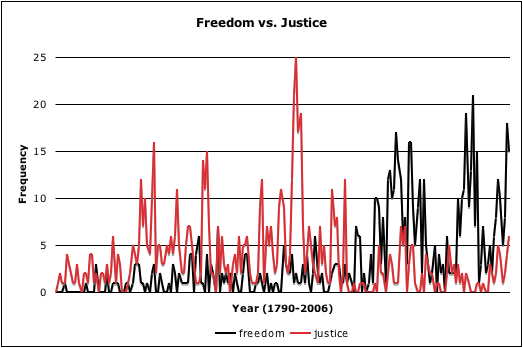|
|
You can make your own word to word comparisons of usage over time with the SotuGraph tool.

Note: Though we have officially stopped updating this site after 2021, the 2025 address was such a radical departure from the tradition, we did it again, maybe one last time. Breach of decorum, consisting of outbursts and interruption from the audience, has become usual since the Biden administration. These outbursts are recorded in the official transcripts, so they have been edited out in order to statistically compare the rhetoric of the president only. We have been analyzing addresses since 2006 and millions of people have visited. We are grateful for your interest and hope it was useful to you. These sort of analyses are now commonplace and the work to maintain and update the site no longer seemed worthwhile. |
|
State of the Union (SOTU) provides access to the corpus of all the State of the Union addresses from 1790 to 2025. SOTU allows you to explore how specific words gain and lose prominence over time, and to link to information on the historical context for their use. SOTU focuses on the relationship between individual addresses as compared to the entire collection of addresses, highlighting what is different about the selected document. You are invited to try and understand from this information the connection between politics and language–between the state we are in, and the language which names it and calls it into being. The WordsSOTU maps the significant content of each State of the Union address so that users can appreciate its key terms and their relative importance. The horizontal axis shows the average position of a word in the document. The vertical axis displays the word’s relative frequency, determined by comparing how frequently the word occurs in the document to how frequently it appears throughout the entire body of SOTU addresses (see appendix for details). Common words (“and,” “the,” etc.) and words that occur frequently in the entire corpus (“states”) are largely filtered out; what remains are words that are especially characteristic of a given address. The size of the word indicates how many times it was used in the document. Click the word to view the full text of the address with the word highlighted. Rollover the word to get detailed frequency data. The DataThe data underneath the map of significant words shows trends in the language of the State of the Union addresses. On the graph, white bars indicate the word length of each address. The red dots indicate readability as measured by the address’s Flesch-Kincaid score, which is meant to suggest the grade level in an American school for which the text is comprehensible. The actual scores are displayed in the bottom right corner of the interface (for more information on Flesch-Kincaid, see the appendix). The current corpus contains 239 documents. There are 1,832,257 words in the corpus, and 28,764 unique words. |